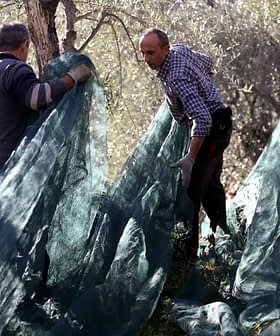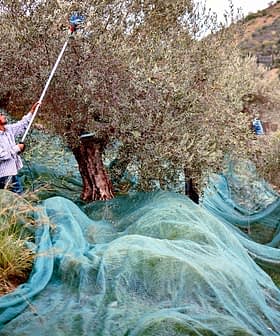International Day of Italian Cuisines Celebrates Spaghetti al Pomodoro
The International Culinary Center hosted the 7th International Day of Italian Cuisines on January 17, celebrating the Feast of Saint Anthony the Abbott and the start of Italian carnival. The event featured workshops on key ingredients in spaghetti al pomodoro, including olive oil, Grana Padano cheese, and tomatoes, emphasizing the importance of PDOs in preserving Italy’s culinary traditions. The day also included the presentation of awards recognizing individuals for their contributions to promoting authentic Italian cuisine in the United States, and concluded with a spaghetti demonstration by three renowned chefs.

The International Culinary Center and its dean of Italian Studies, Chef Cesare Casella, welcomed an audience of restaurateurs, food industry professionals, and journalists for the 7th edition of the International Day of Italian Cuisines. The annual event held on January 17, the day of the Feast of Saint Anthony the Abbott, the patron saint of butchers. January 17 also marks the beginning of Italian carnival, and as wine writer and food expert Alessandra Rotondi stated, “a period of time in which food and drink are celebrated, and transgressions allowed.“
International Culinary Center founder Dorothy Cann Hamilton began the day’s program by welcoming guests to the ICC, an institution that “embraces and loves authentic Italian cuisine.” Hamilton announced the beginning of an ICC legacy scholarship in honor of the late Marcella Hazan, one of the most celebrated authorities on Italian cuisine. The scholarship is designed to send a culinary student to Hazan’s home province of Emilia-Romagna. Hamilton also publicized the ICC’s participation in programming and managing the American pavilion at the 2015 Expo Milan, alongside the James Beard Foundation. Demonstrating her commitment to Italian studies and cuisine, Hamilton will serve as the president of the pavilion.
Chef Casella spoke about the dish at the center of this year’s celebration, spaghetti al pomodoro. Detailing his preferences in sourcing ingredients for the iconic dish, he commented on the simplicity of the Italian staple, which speaks to a “knowledge of ingredients that is the base for Italian cuisine.” Casella introduced Rosario Scarpato, food critic and creator of the International Day of Italian Cuisines. Scarpato explained the many events throughout the world to honor Italian cuisines, but credited New York as the world’s most vibrant, calling New York “the ideal capital of Italian cuisine abroad.”
Scarpato’s remarks were followed by brief workshops detailing three critical ingredients in spaghetti al pomodoro. The first talk concerned olive oil, and heard from Lidia Rinaldi, a consultant for Consorzio Nazionale Degli Olivicoltori (the Italian Consortium of Olive Growers), one of Italy’s largest organizations in the olive oil sector.
In her lecture titled “Traceability and High Quality Extra Virgin Olive Oil,” Rinaldi addressed her organization’s efforts to provide Italian growers with assistance and services to ensure better transparency in the oil market, protect consumer health, and promote trade of the highest quality Italian oils. Praising olive oil as a “fruit juice” that stands as “the king of ingredients of Italian cuisine,” Rinaldi spoke of the consortium’s efforts to create a new market segment for “guaranteed high quality extra virgin olive oil.” Her presentation culminated in a tasting of three Terre del Sole oils, a small sample of Italy’s many diverse varietals and regional flavors.
Moving from an ingredient at the base of spaghetti al pomodoro to an ingredient that is often a finishing touch on the dish, the next workshop was led by Elisabetta Serraiotto, a representative of the Consorzio Grana Padano (Consortium for the Protection of Grana Padano Cheese). Serraiotto detailed the vibrant history of Grana Padano, Italy’s best-selling hard cheese, and the most popular PDO (protected designation of origin) cheese in the world. The consortium represents 130 dairies and 156 aging facilities in the Padano valley, helping producers secure PDO status and safeguard the geographical indication from abuse, unfair competition, and imitation. Although all cheeses that represent Grana Padano are regularly tested for imperfections, the many producers who represent the PDO create cheeses with slightly different characteristics. Covering a large area of northern Italy, the sector that produces this particular cheese employs 50,000 people, producing over 4 million wheels each year with a retail export value of over $3 billion.
Alessandra Rotondi returned for the final ingredient workshop: tomatoes. Describing the vibrant and colorful history of the tomato in Italy and the Americas, Rotondi spoke of early Italian misconceptions of the mysterious fruit and the role of the cookbook in educating populations on the tomato’s uses. Detailing the tomato’s history in the US, from Thomas Jefferson to Joseph Campbell, Rotondi gave great attention to the history of “the marriage of tomatoes and pasta,” both in Italy and abroad.
As in the two previous workshops, Rotondi stressed the importance of PDOs (specifically the San Marzano variety of tomatoes) in Italy’s contemporary gastronomic culture. The presence of place-based labeling and geographical indications in the olive oil, cheese, and tomato industries helps recognize Italy’s connection to culinary tradition. Such designations protect regional diversity from imitation and ensure quality and distinction.
Throughout the day’s events, speakers were joined by video-conferences with two Italian restaurants. Live connections with the President restaurant in Pompeii and Hotel Villa Torreta in Milan featured conversations with chefs, and demonstrations in regional cuisine.
The celebration at the International Culinary Center also featured the presentation of the “Italian Cuisine in the USA Awards.” Recipients included specialty foods merchant Lou di Palo, “for a life long commitment to the promotion of Italian cuisine, its ingredients, and the food and wine culture of Italy.” Two chefs and restaurateurs were recognized “for their lifelong commitment to the promotion of quality, authentic Italian cuisine in the United States”: Dallas-based Francesco Farris, and Walter Potenza, who works and teaches in Providence, Rhode Island. The greatest honor, the prize for “Best Emerging Chef of Italian Cuisine in the USA,” was presented to Justin Smillie, of Il Buco Alimentari & Vineria in New York.
The day’s events culminated in the spaghetti demonstration. Milan-based, Michelin-starred chef Enrico Bartolini served as “Guest Master Chef,” accompanied by New York chef Matteo Bergamini and Dubai-based Luca Signoretti. All three demonstrated preparations of spaghetti al pomodoro with individual technique and distinct flair, using the same ingredients. The three spaghetti expositions concluded with tastings and an opportunity for question-and-answer with the chefs.
What began in 2008 with a celebration of spaghetti alla carbonara has now seen seven years of promoting authentic Italian dishes widely known in the United States, from osso buco to tiramisù. Scarpato stated that, though the day’s goal of celebrating and elevating the authenticity of simple ingredients and Italy’s diverse regions has been a resounding success, its mission is far from over. Forthcoming events will likely commemorate lesser-known Italian dishes to encourage interest in wide-ranging Italian culinary traditions abroad.









